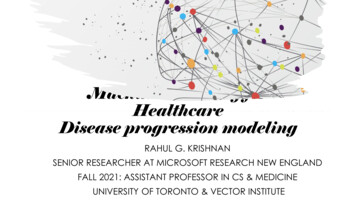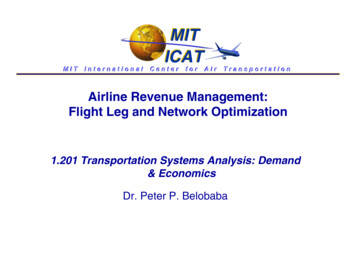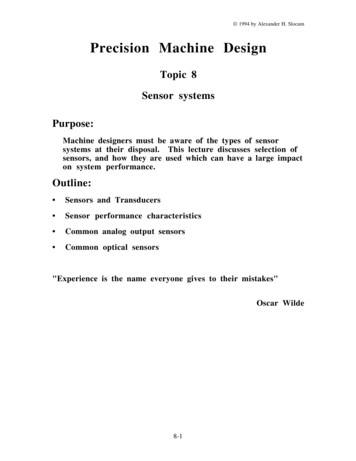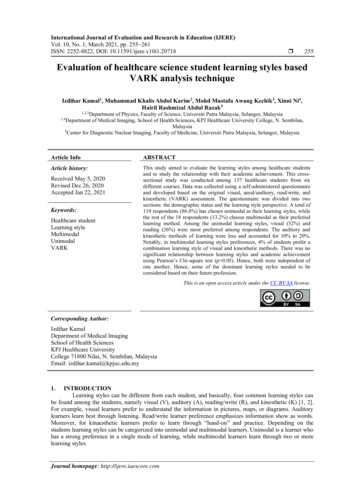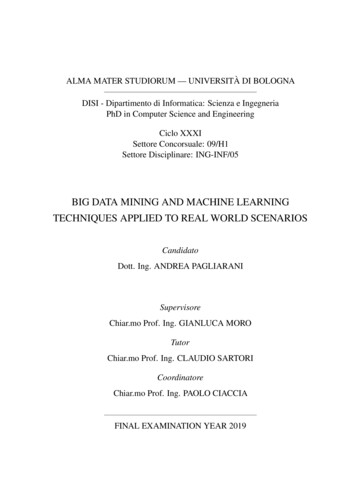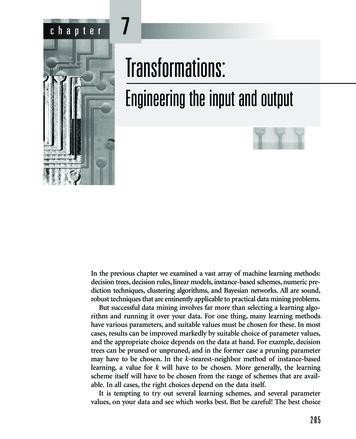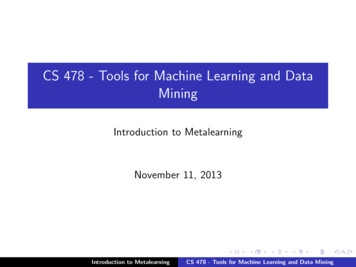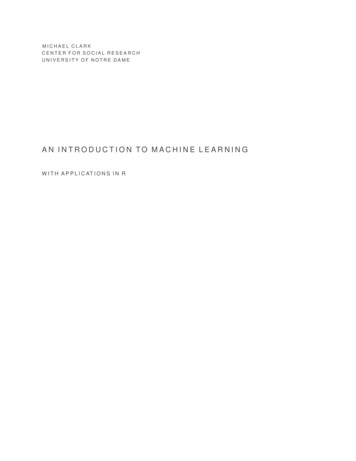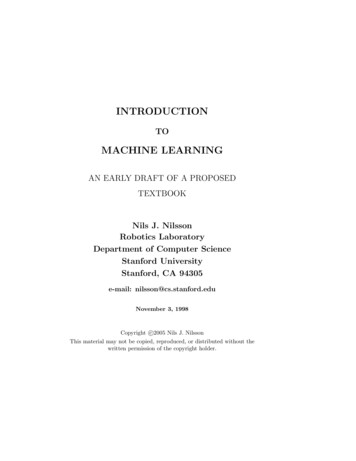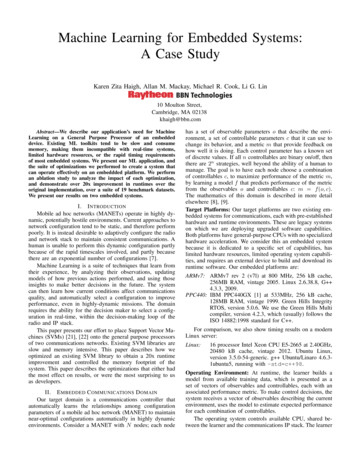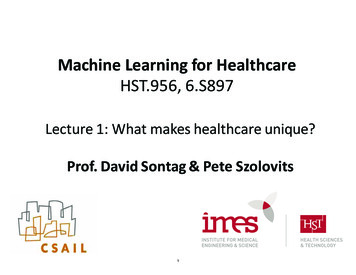
Transcription
Machine Learning for HealthcareHST.956, 6.S897Lecture 1: What makes healthcare unique?Prof. David Sontag & Pete Szolovits1
The Problem Cost of health care expenditures in the US areover 3 trillion, and rising Despite having some of the best clinicians inthe world, chronic conditions are– Often diagnosed late– Often inappropriately managed Medical errors are pervasive2
Outline for today’s class1. Brief history of AI and ML in healthcare2. Why now?3. Examples of how ML will transformhealthcare4. What is unique about ML in healthcare?5. Overview of class syllabus3
1970’s: MYCIN expert system 1970’s (Stanford): MYCIN expertsystem for identifying bacteriacausing severe infections Proposed a good therapy in 69% of cases. Better thaninfectious disease expertsEXPERTSYSTEMUSERIDescription of newcaseAdvice&ExplanationUserinterfaceDialogue interfaceI amready** THISIS A 26 YEAROLDMALEPATIENTMyunderstandingis:Theageof thepatientis 26Thesexof thepatientis male** FIVE DAYSAGO,HE HADRESPIRATORY-TRACTSYMPTOMSWhatis his name?** JOMyunderstandingis:Thenameof thepatientis JoRespiratory-tractis oneof thesymptomsthat thepatienthad** A COUPLEOFDAYSBEFORETHEADMISSION,HEHADA MALAISEPleasegive methedateof admissionqp InferenceEngine** MARCH12, 1979Myunderstandingis:Thepatientwasadmittedat thehospital3 daysagoMalaiseis oneof thesymptomsthatthepatienthad5 daysagotqp KnowledgeBase [FIGURE33-1 Short sample dialogue. The physician’sappearin capital letters after the double asterisks.FIGURE1-1 Majorparts of an expert system. Arrowsindicateinformationflow.inputs4 Addison-Wesley Publishing Company, Inc. This content is excluded from our Creative Commons license. For more information, see https://ocw.mit.edu/help/faq-fair-use/
2%*UQ93)WX#S XW"# 2 aP )7@F-:! 2%*UQ9)YG; H )@C)? //9A01K5Z3WX#S XW"# 2 a0 .8)P-F .6: -C-1-;.! L 6K;@9 9)C@1) ;/-1;6:)7-F . ;C:0 E;-07@; 6 F 6A-/-9L 9-69-9& U)A ;61O)F 9-69-)H61 6A:-9T(U &)A ;61O)9O7E/@7)H61 6A:-9)T&(T U)F 1-./-F)-FK-9S: . /-F)C1@7)F@./@193:B(C'*9-&D '"*9(-,(E-*F)'5(0-("54"&#'9(%&(!)(7( (G;" '9%"&(&'0E-*F9H("CC*-I%@"0'(%&,'*'&#'J"O7E/@79C6/ K0- .@0K51*-?"?%/%90%#(@-5'/(*'/"0%& A.5-9/ 5 K5E6 ; b2B1*-?/'@9A 2 B: ; . 6;9)-;/-1-F)9O7E/@79)()! )** R L CC .0:/)/@)76 ;/6 ;()F CC .0:/)/@)K-;-16: f5cP ::-1)-/)6: ()d*'()"5M- -/)6: ()d%2e
1980’s: automating medical discoveryDiscovers that prednisoneelevates cholesterol(Annals of Internal Medicine, ‘86)[Robert Blum, “Discovery, Confirmation and Incorporation of Causal Relationshipsfrom a Large Time-Oriented Clinical Data Base: The RX Project”. Dept. of ComputerScience, Stanford. 1981]6Diagram Robert Blum. All rights reserved. This content is excluded from our Creative Commons license. For more information, see https://ocw.mit.edu/help/faq-fair-use/
1990’s: neural networks in medicine Neural networks withclinical data took off in1990, with 88 new studiesthat year Small number of features(inputs) Data often collected bychart reviewFIGURE 2.tronAmultilayer perceptron. Thisinputs, four hidden units,with fouris aandtwo-layeronepercep-output unit.Problems: 1. Did not fit well into clinical workflow2. Hard to get enough training data3. Poor generalization to new places[Penny & Frost, Neural Networks in Clinical Medicine. Med Decis Making, 1996]7 Society for Medical Decision Making. All rights reserved. This content is excluded from our Creative Commons license.For more information, see https://ocw.mit.edu/help/faq-fair-use/
Outline for today’s class1. Brief history of AI and ML in healthcare2. Why now?3. Examples of how ML will transformhealthcare4. What is unique about ML in healthcare?5. Overview of class syllabus8
The Opportunity:Adoption of Electronic Health Records00000(EHR) has increased 9x in USsince 200885.2%*Certi ed EHR94%*75.5%*71.9%Basic EHRPercentageof hospitalsin the 0915.6%201020112012201320142015Courtesy of Health and Human Services. Image is in the public domain.[Henry et al., ONC Data Brief, May 2016]9
,61K-)F6/69-/9,6A@16/@1O) C@1)B@7E0/6/ @;6:)?5O9 @:@KOL- F-;/ C -F)5-6:/5)F6/6)C1@7)[TUm).1 / .6:).61-)E6/ -;/9L-7@K16E5 .9()H /6:)9 K;9():6A@16/@1O)/-9/9()7-F .6/ @;9();@/-9()n Lab for Computational Physiology. All rights reserved. This content is excluded from10our Creative Commons license.For more information, see https://ocw.mit.edu/help/faq-fair-use/
Large datasetsPresident Obama’s initiative to create a 1 millionperson research cohortCore data set: Baseline health exam Clinical data derivedfrom electronic healthrecords (EHRs) Healthcare claims Laboratory data[Precision Medicine Initiative (PMI) working Group Report, Sept. 17 2015]11
L H-19 /O)@C)F K /6:)5-6:/5)F6/6proteomicslab testsphonevital signsmages areovernment wor . mages are in the public domain.imagingsocial media12devicesgenomics
"/6;F61F f6/ @;! L 6K;@9 9).@F-93)WBL %)6;FWBL 2U)YW;/-1;6/ @;6:B:699 C .6/ @;)@C)L 9-69-9Znnn5//E93 -; M 8 E-F 6 @1K M 8 , 9/p@CpWBL %p.@F-95//E93 A:@K .01-7F .@7 /5- 7@9/ A f611- .F 2U .@F-9 ;C@K16E5 . 13
"/6;F61F f6/ @;! L 6K;@9 9).@F-93)WBL %)6;FWBL 2U)YW;/-1;6/ @;6:B:699 C .6/ @;)@C)L 9-69-9Z! ,6A@16/@1O)/-9/93),NWXB.@F-9! ?56176.O3)X6/ @;6:)L10KB@F-9)YXLB9Z! G; C -F)P-F .6:),6;K06K"O9/-7)YGP,"Z3)7 :: @;9)@C7-F .6:).@;.-E/9 O C. All rights reserved. This content is excludedfrom our Creative Commons license. For moreinformation, see https://ocw.mit.edu/help/faq-fair-use/ Oplinc.14All rights reserved. This content is excluded from our Creative Commonslicense. For more information, see https://ocw.mit.edu/help/faq-fair-use/
"/6;F61F f6/ @;mage is in the public domain.15
StandardizationOMOPCommonDataModel v5.0Image is in the public domain.16
]1-68/51@0K59) ;)76.5 ;-):-61; ;K %&'!"#(! ] K)F6/6! b:K@1 /57 .)6FH6;.-9! NE-; 9@01.-)9@C/M61 conomist and tanford ision a . All rights reserved. This content is excluded from our Creative Commons license. For more information,17see https://ocw.mit.edu/help/faq-fair-use/
Breakthroughs in machine learning Major advances in ML & AI– Learning with high-dimensional features (e.g., l1regularization)– Semi-supervised and unsupervised learning– Modern deep learning techniques (e.g. convnets,variants of SGD) Democratization of machine learning– High quality open-source software, such asPython’s scikit-learn, TensorFlow, Torch, Theano18
19 Rock Health. All rights reserved. This content is excluded from our Creative Commons license.For more information, see https://ocw.mit.edu/help/faq-fair-use/
C nformation ervices. All rights reserved. This content is excluded from 20our Creative Commons license. For more information, seehttps://ocw.mit.edu/help/faq-fair-use/
Industry interest in ML & healthcare Major acquisitions to get big data for ML:– Merge ( 1 billion purchase by IBM, 2015)medical imaging– Truven Health Analytics ( 2.6 billion purchase byIBM, 2016)health insurance claims– Flatiron Health ( 1.9 billion purchase by Roche,2018)electronic health records (oncology)21
Outline for today’s class1. Brief history of AI and ML in healthcare2. Why now?3. Examples of how ML will transformhealthcare4. What is unique about ML in healthcare?5. Overview of class syllabus22
P,)M F-19323
Emergency Department: Limited resources Time sensitive Critical decisions24Courtesy of the US Navy. Image is in the public domain.
456/)M ::)/5-)S )@C)/5-)C0/01-)A-): 8- ]-5 ;F /5- 9.-;-9)1-69@; ;K)6A@0/)/5-)E6/ -;/Q9).@;F / @;9)Y.011-;/)6;F)C0/01-ZC:0 E;-07@; 6 F 6A-/-9L 9-69-9L1 H-9"O7E/@79C6/ K0- .@0K5.5-9/ 5 K5E6 ; b2Bb0/@76/ .6::O)-D/16./-F)C1@7)-:-./1@; .)5-6:/5)1-.@1F25! ]-//-1)/1 6K! l69/-1)F 6K;@9 9! S61:O)F-/-./ @;)@C6FH-19-)-H-;/9! ?1-H-;/)7-F .6:-11@19
456/)M ::)/5-)S )@C)/5-)C0/01-)A-): 8- ?1@E6K6/ ;K)A-9/)E16./ .-9)26 source un nown. All rights reserved. This content is excluded from our CreativeCommons license. For more information, see https://ocw.mit.edu/help/faq-fair-use/
456/)M ::)/5-)S )@C)/5-)C0/01-)A-): 8- b;/ . E6/ ;K)/5-).: ; . 6;9Q;--F927 source un nown. All rights reserved. This content is excluded from our CreativeCommons license. For more information, see https://ocw.mit.edu/help/faq-fair-use/
456/)M ::)/5-)S )@C)/5-)C0/01-)A-): 8- -F0. ;K)/5-);--F)C@1)9E-. 6: 9/).@;90:/9InputChest X-Ray ImageCheXNet121-layer CNNOutputPneumonia Positive (85%)b115O/57 6 a pur ar et al. All rights reserved. This content is excluded from ourCreative Commons license. For more information,see https://ocw.mit.edu/help/faq-fair-use/28l K01-) 9@01.-93) 6iE01861 -/)6: ()61h H32 22 U&RR&)Q2 6iE01861 -/)6: ()61h H32 U U2*J'()q2
456/)M ::)/5-)S )@C)/5-)C0/01-)A-): 8- b0/@76/-F)F@.07-;/6/ @;)6;F)A :: ;K#1 6K-);@/-?1-F ./-F).5 -C).@7E:6 ;/9B@;/-D/06:)60/@.@7E:-/29 source un nown. All rights reserved. This content is excluded from our Creative Commons license. For more information, see https://ocw.mit.edu/help/faq-fair-use/
P,)M F-19330
456/) 9)/5-)C0/01-)@C)5@M)M-)/1-6/).51@; .)F 9-69- ! ?1-F ./ ;K)6)E6/ -;/Q9)C0/01-)F 9-69-)E1@K1-99 @;R%@'Disease burdenUndiagnosedconditionCourtesy of the CDC. Image is in the public domain.31l K01-).1-F /3)5//E93 MMM .F. K@H 8 F;-OF 9-69- E1-H-;/ @; 1 98 5/7:# 7-
456/) 9)/5-)C0/01-)@C)5@M)M-)/1-6/).51@; .)F 9-69- ! ?1-F ./ ;K)6)E6/ -;/Q9)C0/01-)F 9-69-)E1@K1-99 @;! ?1-. 9 @;)7-F . ;S --9%& (,%*90(/%&'(0 '*"C (%&(@Q/0%C/'(@ '/-@" J TU5A .61C :f@7 A :-;6: F@7 F- F-D67-/569@;-();J(VU5A A@1/-f@7 A :-;6: F@7 F- F-D67-/569@;Progression on KRdDiagnosis and first-line treatmentProgression on VRdTreatment AResponse to treatment APatient w.condition XTreatment BResponse to treatment B32# 7-
What is the future of how we treatchronic disease? Early diagnosis, e.g. of diabetes, Alzheimer's,cancer Continuous monitoring and coaching, e.g. for theelderly, diabetes, psychiatric disease Discovery of new disease subtypes; design ofnew drugs; better targeted clinical trials33
Outline for today’s class1. Brief history of AI and ML in healthcare2. Why now?3. Examples of how ML will transformhealthcare4. What is unique about ML in healthcare?5. Overview of class syllabus34
What makes healthcare different? Life or death decisions– Need robust algorithms– Checks and balances built into ML deployment– (Also arises in other applications of AI such as autonomousdriving)– Need fair and accountable algorithms Many questions are about unsupervised learning– Discovering disease subtypes, or answering question suchas “characterize the types of people that are highly likely tobe readmitted to the hospital”? Many of the questions we want to answer are causal– Naïve use of supervised machine learning is insufficient35
What makes healthcare different? Very little labeled data– Motivates semi-supervised learning algorithms Sometimes small numbers of samples (e.g., arare disease)– Learn as much as possible from other data (e.g.healthy patients)– Model the problem carefully Lots of missing data, varying time intervals,censored labels36
What makes healthcare different? Difficulty of de-identifying data– Need for data sharing agreements and sensitivity Difficulty of deploying ML– Commercial electronic health record software isdifficult to modify– Data is often in silos; everyone recognizes need forinteroperability, but slow progress– Careful testing and iteration is needed37
Goals for the semester Intuition for working with healthcare data How to set up as machine learning problems Understand which learning algorithms arelikely to be useful and when Appreciate subtleties in safely & robustlyapplying ML in healthcare Set the research agenda for the next decade38
6.S897/HST.956 vs 6.874 Our class will focus on clinical data and its useto improve health care For reasons of time & scope, we will not godeep into applications in the life sciences– For this, we recommend taking 6.874Computational Systems Biology: Deep Learningin the Life Sciences39
MIT OpenCourseWarehttps://ocw.mit.edu6.S897 / HST.956 Machine Learning for HealthcareSpring 2019For information about citing these materials or our Terms of Use, visit: https://ocw.mit.edu/terms40
Machine Learning for Healthcare HST.956, 6.S897 Lecture 1: What makes healthcare unique? Prof.David Sontag & Pete Szolovits The Problem Costof health careexpenditures in the US are over 3 trillion, and rising Despite having some of the best clinicians in theworld, chronic conditions are – Oftendiagnosed late – Ofteninappropriatelymanaged Medicalerrors are pervasive Outlinefor .
